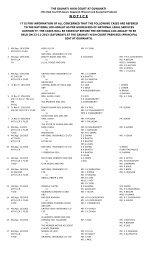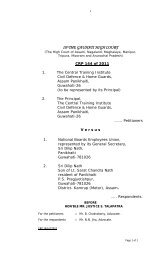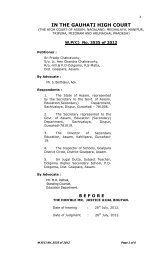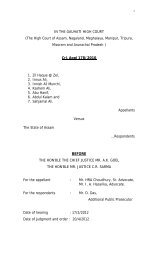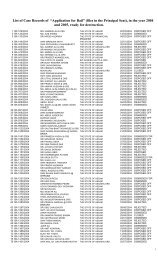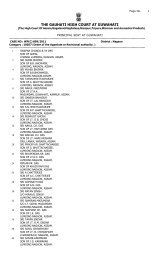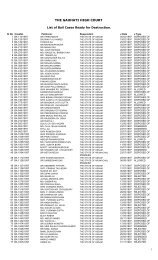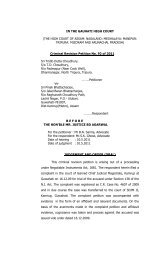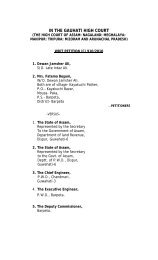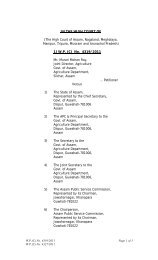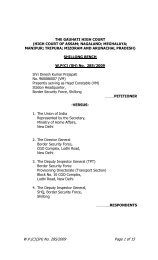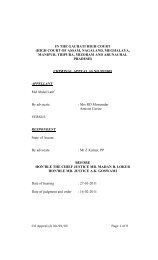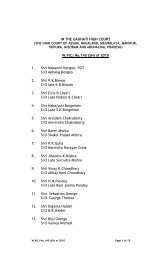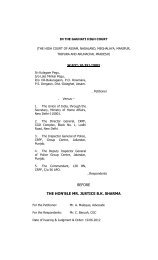Crl.A. 81/2009 - Gauhati High Court
Crl.A. 81/2009 - Gauhati High Court
Crl.A. 81/2009 - Gauhati High Court
You also want an ePaper? Increase the reach of your titles
YUMPU automatically turns print PDFs into web optimized ePapers that Google loves.
IN THE GAUHATI HIGH COURT<br />
(THE HIGH COURT OF ASSAM, NAGALAND, MEGHALAYA<br />
MANIPUR, TRIPURA, MIZORAM AND ARUNACHAL PRADESH)<br />
CRIMINAL APPEAL NO.<strong>81</strong> OF <strong>2009</strong>.<br />
1. Sri Haren Das @ Ramen Das,<br />
Son of Late Aditya Das.<br />
2. Sri Puspa Das,<br />
Son of Sri Drona Das.<br />
3. Sri Kanti Das,<br />
Son of Sri Dandi Das.<br />
4. Sri Bapkon Das,<br />
Son of Sri Dandi Das.<br />
5. Sri Makhana Das,<br />
Son of Late Aditya Das.<br />
All are resident of village – Mahara<br />
Borchapari, P.O. Ghunasuti, P.S.
2<br />
North Lakhimpur, District : Lakhimpur,<br />
Assam.<br />
… APPELLANTs<br />
-Versus-<br />
The State of Assam.<br />
…RESPONDENTS<br />
P R E S E N T<br />
THE HON’BLE CHIEF JUSTICE<br />
THE HON’BLE MR. JUSTICE A.C. UPADHYAY<br />
For the appellants : Mr. M. Choudhury,<br />
Mr. P. Hazarika,<br />
Mr. A Gogoi, Advocates<br />
For the Respondents : Mr. Z. Kamar, P.P.<br />
Date of hearing : 13.12.2011.<br />
Date of Judgment : : 3.2.2012
3<br />
JUDGMENT AND ORDER<br />
(A.C. Upadhyay, J)<br />
1. Extant appeal is directed against the judgment and order dated<br />
2.4.<strong>2009</strong>, passed by the learned Sessions Judge, Lakhimpur, Assam,<br />
in Sessions Case No.104 (NL)/2007, whereby each of the appellants<br />
above named were convicted under Sections 143/147/148 IPC and<br />
sentenced to undergo Rigorous Imprisonment for three (3) months<br />
and to pay a fine of Rs.500/-.<br />
2. Additionally, the appellant No.1, Haren Das was convicted<br />
under Section 325/149 IPC and sentenced to undergo Rigorous<br />
Imprisonment for one (1) year and to pay a fine of Rs.1,000/- with<br />
default stipulation. Appellant Nos.2 and 3 namely, Sri Puspa Das and<br />
Sri Kanti Das, have also been convicted under Section 324/148 IPC<br />
and each of them were sentenced to undergo Rigorous Imprisonment<br />
for six (6) months and to pay fine of Rs.500/- with default stipulation<br />
and the appellant Nos.4 and 5, namely, Sri Bapkon Das and Sri<br />
Makhana Das have been convicted under Section 323/149 IPC and<br />
sentenced to undergo RI for two (2) months and to pay a fine of<br />
Rs.500/- with default stipulation.<br />
3. The facts leading to the filing of this appeal by the above<br />
named appellant may be stated, briefly, as follows –
4<br />
Shri Rupen Chutia had lodged an FIR on 10.12.2004, before<br />
the Officer-in-charge, North Lakhimpur Police Station, alleging therein<br />
that on 10.12.2004, at about 7 A.M., while his brothers, Sri Tiken<br />
Chutia and Sri Khadeswar Chutia were ploughing their paddy land,<br />
they were assaulted by Sri Dandi Das, Sri Aditya Das, Sri Drona Das,<br />
Sri Kanti Das, Sri Bapkon Das and Sri Arun Das. As a result of the<br />
assault so made on the injured, they became senseless at the place of<br />
occurrence, wherefrom they were taken to the hospital for treatment.<br />
4. On the basis of the FIR, the police registered a case and<br />
launched investigation. On completion of the investigation, the<br />
Investigating Officer of North Lakhimpur Police Station, submitted<br />
charge sheet against the appellants above named alleging commission<br />
of offence under Section 143/147/148/149/447/323/325/326 IPC.<br />
Offences alleged against the appellants were triable by the Judicial<br />
Magistrate, Ist Class.<br />
5. During trial, all the charge sheeted accused entered<br />
appearance before the learned Magistrate and accordingly formal<br />
charges as noted above were framed against all the appellants and<br />
accordingly the recording of the evidence of the witnesses ensued.<br />
6. In all nine (9) witnesses were examined by the prosecution<br />
before the trial <strong>Court</strong>, thereafter, the trial court record of the case was
5<br />
called for by the learned Sessions Judge, for analogous trial and<br />
disposal, since a cross case bearing Sessions Case No.110(NL)/07,<br />
arising out of the same transaction, was also pending for trial before<br />
learned Sessions <strong>Court</strong>, Lakhimpur, for alleged commission of offence<br />
under Section 324/302/34 IPC, against the accused Tiken Chutia and<br />
Bogen Chutia.<br />
7. Consequently, both the cases noted above were taken up for<br />
trial by the learned Sessions Judge. On completion of the trial, the<br />
learned Sessions Judge, Lakhimpur, convicted the accused-appellant<br />
as aforesaid giving rise to this appeal. However, it may not be out of<br />
place to mention herein that in Sessions Case No.10(NL)/07, the<br />
learned Sessions Judge, on conclusion of trial found that the accused<br />
Tiken Chutia guilty of committing offence of murder of deceased<br />
Aditya and accordingly convicted him of offence under Section 302<br />
IPC and sentenced him to undergo RI for life and also to pay fine<br />
with default stipulation.<br />
8. Though this appeal arising out of the conviction recorded by<br />
the learned Sessions Judge, in usual course is required to be heard by<br />
the learned Single Judge of this <strong>Court</strong>, however, when the appeal was<br />
taken up by the learned Single Judge it was observed that since<br />
Criminal Appeal No.132 of <strong>2009</strong>, arising out of the same transaction,<br />
preferred by the appellant Tiken Chutia, against the judgment and<br />
order of the conviction under Section 302 IPC, was pending before the
6<br />
Division Bench, both the appeals may be conveniently heard together.<br />
In view of the above observation so made by the learned Single<br />
Judge, the Hon’ble Chief Justice, directed the Registry to list both the<br />
appeals, as stated above, for hearing and disposal by the same<br />
Division Bench.<br />
9. Mr. M. Choudhury, learned counsel appearing for the appellants<br />
submitted that the undue reliance has been put by the learned trial<br />
<strong>Court</strong> on the evidence of witnesses PW-1, PW-2, PW-4, PW-5, PW-6<br />
and PW-7, who were either hearsay witnesses or reported witnesses<br />
in respect of the alleged incident.<br />
10. Learned counsel for the appellants pointed out that the learned<br />
trial <strong>Court</strong> acted erroneously in convicting the accused-appellant, since<br />
the prosecution and its witnesses i.e. PW-2 and PW-8 have not<br />
explained the fatal injuries caused to one of the alleged aggressor,<br />
namely i.e. Aditya Das, in the incident, who succumbed to the injuries<br />
caused by the witnesses. More so, the entire incident took place in<br />
land in possession of the accused appellants. The incident took place<br />
when the injured victims tried to dispossess the occupier of the land<br />
in the question. The aforesaid fact cast a serious doubt on the<br />
genuineness of the prosecution story, since the witnesses themselves<br />
admitted that the accused Aditya Das had sustained the fatal injuries<br />
in the course of the same incident.
7<br />
11. Learned counsel for the appellants further pointed out that the<br />
evidence on record clearly establishes that the injured witnesses were<br />
neither owners nor in possession of the land in question where the<br />
alleged occurrence had taken place and PW-8 categorically admitted<br />
that the land in question did not belong to them. So also PW-3 and<br />
PW-7 deposed that the land in question was in possession of Aditya<br />
Das, (deceased). Therefore, the injured witnesses had tried to<br />
disposes the accused persons including deceased Aditya Das from the<br />
aforesaid land.<br />
Learned counsel pointed out that in view of the above, if<br />
there was any common object of the appellants, it was to enforce<br />
their own right of enjoyment and possession over the property, they<br />
owned. Therefore, in any view of the matter, the accused-appellant<br />
deserves to be protected for having exercised the right of the private<br />
defence of person and their property.<br />
12. However, the learned Public Prosecutor would submit that the<br />
judgment of the learned Sessions Judge, in the facts and<br />
circumstances of the case do not deserve to be interfered with.<br />
13. In order to appreciate, the rival contention made by the<br />
learned counsel for the parties, it would be appropriate to discuss the<br />
evidence of the witnesses adduced by the prosecution as well as the<br />
defence.
8<br />
14. PW-1, Sri Rupen Chutia, is not the eye witness to the<br />
occurrence. PW-2, Sri Tiken Chutia, who is one of the injured deposed<br />
that at the time of occurrence, he along with his brother, Bogen<br />
Chutia was ploughing the paddy field. Meanwhile, the accused Sri<br />
Bapkon Das, Sri Makhana Das, Sri Haren Das, Sri Kanti Das and Sri<br />
Puspa Das attacked them by means of lathies, spades, etc. According<br />
to him, Puspa Das had injured his brother on the back of the chest by<br />
means of spear. Seeing this, when PW-2 advanced to help his brother,<br />
accused, Sri Kanti Das had injured him on his head by means of dao.<br />
Thereafter, the other accused also had beaten him on his legs and<br />
hands by means of lathies, spears, etc. PW-2 further stated that Sri<br />
Haren Das had injured his brother by means of lathies on the right<br />
leg, for which his brother sustained fracture injury. Meanwhile, PW-2<br />
admitted to have heard Aditya Das(deceased) asking the accused not<br />
to beat him, and after a little while he heard Adity Das shouting “I am<br />
dead”. Thereafter, all the accused went away from the place of<br />
occurrence. After sometime, some people came to the place of<br />
occurrence and his brother was taken from their house and to the<br />
hospital for treatment.<br />
15. During cross examination, PW-2, Tiken Chutia denied the<br />
defence suggestion that the accused Sri Puspa Das had injured his<br />
brother by means of spear and that accused, Sri Kanti Das had injured<br />
him on his head by means of a dao and accused, Sri Haren Das had<br />
injured his brother on the leg causing fracture injury.
9<br />
16. On careful appraisal of the evidence of the prosecution<br />
witnesses we find that it could not be established by the prosecution<br />
that the injured were in possession of the land in dispute, where the<br />
occurrence had taken place. The land was admittedly the bone of<br />
contention. The evidence of PW-8 do not clearly indicate as to who<br />
had injured him. PW-6 and PW-7 clearly deposed that Late Aditya<br />
Das, prior to his death was cut and injured by the injured witness<br />
PW-2 ,Sri Tiken Chutia. However, apparently, the aforesaid statement<br />
of the witness, which basically answered the reason for attack and<br />
counter attack was not taken into consideration by the learned<br />
Sessions Judge. Admittedly, both the injured witnesses were accused<br />
of committing murder of late Adity Das. As stated by PW-2, Tiken<br />
Chutia, when he was ploughing in the field quarrel took place in<br />
respect of plot of land, which was in possession of Aditya Das at the<br />
relevant time.<br />
17. PW-4 and 5, did not see the occurrence. PW-6 categorically<br />
stated that after the incident, when he met injured Aditya in an<br />
injured condition when he was about to be taken to the hospital .<br />
P.W.6 was told by Aditya that he was stabbed by Tiken Chutia. PW-7<br />
also stated that Tiken Chutia has assaulted Aditya Das.<br />
18. In the case of Takhaji Hiraji v. Thakore Kubersing<br />
Chamansing and Ors reported in (2001) 6 SCC 145,<br />
question<br />
which arose for consideration is what is the effect of non-explanation
10<br />
of injuries sustained by the accused persons. The Apex <strong>Court</strong><br />
observed that in Rajender Singh v. State of Bihar (2000) 4 SCC<br />
298 : Ram Sunder Yadav v. State of Bihar (1998) 7 SCC 365<br />
and Vijayee Singh v. State of U.P. (1990) 3 SCC 190, all three-<br />
Judge Bench decisions, the view taken consistently is that it cannot be<br />
held as a matter of law or invariably a rule that whenever the accused<br />
sustained an injury in the same occurrence, the prosecution is obliged<br />
to explain the injury and on the failure of the prosecution to do so the<br />
prosecution case should be disbelieved. Before non-explanation of the<br />
injuries on the persons of the accused persons by the prosecution<br />
witnesses may affect the prosecution case, the court has to be<br />
satisfied of the existence of two conditions: (i) that the injury on the<br />
person of the accused was of a serious nature; and (ii) that such<br />
injuries must have been caused at the time of the occurrence in<br />
question. Non-explanation of injuries assumes greater significance<br />
when the evidence consists of interested or partisan witnesses or<br />
where the defence gives a version which competes in probability with<br />
that of the prosecution. Where the evidence is clear, cogent and<br />
creditworthy and where the court can distinguish the truth from<br />
falsehood the mere fact that the injuries on the side of the accused<br />
persons are not explained by the prosecution cannot by itself be a<br />
sole basis to reject the testimony of the prosecution witnesses and<br />
consequently the whole of the prosecution case.
11<br />
19. In the present case, Aditya Das, who had accompanied the<br />
accused appellants was killed in the incident. There is no explanation<br />
by the prosecution as to how the injuries were caused to Aditya Das.<br />
When in the incident Aditya died due the injuries, the prosecution<br />
owed an explanation, which is missing conspicuously.<br />
20. Now the question which arises for consideration is whether the<br />
accused-appellants, who were in possession of the land in question<br />
exercised their right of private defence of person and property<br />
respectively.<br />
21. The scope and width of private defence is clearly explained in<br />
Section 102 to 105 IPC, which deals with the commencement and<br />
continuation of the right of private defence of body and property<br />
respectively. According to the provision of law as aforesaid, the right<br />
commences as soon as reasonable apprehension of danger to the<br />
body and the property arises from attempt or threat to commit<br />
offence. Although the offence may not have been committed ,but the<br />
right of private defence will continue, until there is reasonable<br />
apprehension of the danger and the right of private defence would<br />
last as long as reasonable apprehension of the danger to the personal<br />
property continues.<br />
22. As a matter of fact, right of private defence is a defensive right.<br />
It is neither a right of aggression nor of a reprisal. There is no right
12<br />
of private defence, where there is no apprehension of danger. The<br />
right of private defence is available only to such person, who is<br />
suddenly confronted with the necessity of averting danger, which is<br />
not self created. Such necessity must be real and apparent.<br />
23. In the case of Laxman Sahu Vs. State of Orissa reported<br />
in AIR 1988 SC 83, the Apex <strong>Court</strong> laid the basic principle and also<br />
underlined the doctrine of the right of the private defence that when<br />
an individual or his property is faced with danger and immediate aid is<br />
necessary, which is not readily available, such individual is entitled to<br />
protect himself and his property from the aggression. Therefore, the<br />
necessary corollary in the circumstances that the violence which the<br />
person defending himself or his property is entitled, must not be<br />
unduly disproportionate to the injury, which is sought to be averted<br />
and should not exceed its legitimate purpose. Nevertheless, such<br />
exercise of right of private defence can never be vindictive or<br />
malicious. Otherwise, it would be repugnant to the very concept of<br />
private defence. The Apex <strong>Court</strong> in Vidhya Singh Vs. State of<br />
Madhya Pradesh reported in 1971 (3) SCC 244 had observed<br />
that right of self defence should not be construed narrowly, because<br />
its valuable right and has social purpose.<br />
24. In the light of the above discussion, it will have to be seen that<br />
whether right of the private defence was available to the appellants or<br />
not. To do so the action for and the injury received by the accused,
13<br />
proximate threat to his safety the injuries caused by the accused and<br />
circumstances, whether the accused had time enough to take<br />
recourse to other safety measure are relevant consideration. It also<br />
cannot be held as unqualified proposition of law that whenever<br />
injuries on the body of the accused persons, is found the presumption<br />
must necessary be raised the accused person had caused injuries in<br />
exercise of the right of the private defence. The defence has to<br />
further establish that the injuries so caused on the accused probabilize<br />
the version of the right of private defence.<br />
25. The plea of self defence has been rejected by the trial <strong>Court</strong> on<br />
the ground that the appellants did not come forward to establish such<br />
plea. While doing so, the learned trial <strong>Court</strong> rejected the stand of the<br />
appellants that they were in exclusive possession of the land in<br />
question which was forcibly ploughed by the injured. Admittedly,<br />
Aditya Das, who was owner of the land in question, was killed in the<br />
incident by the injured of this case. Unfortunately, Aditya admittedly<br />
had no weapon in his hands. Therefore, apparently, the injured<br />
witnesses were the aggressors, who threatened to grab the property<br />
belonging to Aditya Das and his family members.Admittedly his<br />
genuine effortto settle the dispute amicably was misunderstood.<br />
Instead of listening to him, the poor harbinger of peace was done to<br />
death by an unlawful act .
14<br />
26. When head of the family, who tried to barter peace was<br />
brutally attacked and assaulted , in presence of other family<br />
members , in a flash of emotions coupled with their inherent right to<br />
defend and save Aditya from the<br />
,exercised their right to protect him .<br />
assault by the attackers<br />
Therefore, the accusedappellants<br />
who had been to the land to plough were confronted by<br />
the aggression of the injured and the witness. In such a situation, the<br />
appellants had the right to resist the aggressor to thwart the illegal<br />
dispossession and assault made on Aditya. Unfortunately,<br />
the<br />
injured Aditya Das was killed and others were injured. The minor<br />
injury caused upon the injured do spell out that the accused did not<br />
exceeded the right of private defence of the property and the person.<br />
In our considered opinion, the appellant very well established that<br />
they were exercising right of private defence of their personal<br />
property at the time of occurrence.<br />
27. In Darshan Singh v. State of Punjab, (2010) 2 SCC 333<br />
,the Apex observed that when enacting Sections 96 to 106 of the<br />
Penal Code, excepting from its penal provisions, certain classes of<br />
acts, done in good faith for the purpose of repelling unlawful<br />
aggressions, the legislature clearly intended to arouse and encourage<br />
the manly spirit of self-defence amongst the citizens, when faced with<br />
grave danger. The law does not require a law-abiding citizen to<br />
behave like a coward when confronted with an imminent unlawful
15<br />
aggression. As repeatedly observed by this <strong>Court</strong> there is nothing<br />
more degrading to the human spirit than to run away in face of<br />
danger. The right of private defence is thus designed to serve a social<br />
purpose and deserves to be fostered within the prescribed limits.<br />
28. In Darshan Singh v. State of Punjab (supra) the Apex<br />
<strong>Court</strong> culled out the following principles on scrutiny of the its land<br />
mark judgments on the subject, as follows :<br />
(i) Self-preservation is the basic human instinct and is duly<br />
recognised by the criminal jurisprudence of all civilised<br />
countries. All free, democratic and civilised countries<br />
recognise the right of private defence within certain<br />
reasonable limits.<br />
(ii) The right of private defence is available only to one who<br />
is suddenly confronted with the necessity of averting an<br />
impending danger and not of self-creation.<br />
(iii) A mere reasonable apprehension is enough to put the<br />
right of self-defence into operation. In other words, it is not<br />
necessary that there should be an actual commission of the<br />
offence in order to give rise to the right of private defence.<br />
It is enough if the accused apprehended that such an<br />
offence is contemplated and it is likely to be committed if<br />
the right of private defence is not exercised.<br />
(iv) The right of private defence commences as soon as a<br />
reasonable apprehension arises and it is coterminous with<br />
the duration of such apprehension.<br />
(v) It is unrealistic to expect a person under assault to<br />
modulate his defence step by step with any arithmetical<br />
exactitude.<br />
(vi) In private defence the force used by the accused ought<br />
not to be wholly disproportionate or much greater than<br />
necessary for protection of the person or property.
16<br />
(vii) It is well settled that even if the accused does not<br />
plead self-defence, it is open to consider such a plea if the<br />
same arises from the material on record.<br />
(viii) The accused need not prove the existence of the right<br />
of private defence beyond reasonable doubt.<br />
(ix) The Penal Code confers the right of private defence<br />
only when that unlawful or wrongful act is an offence.<br />
(x) A person who is in imminent and reasonable danger of<br />
losing his life or limb may in exercise of self-defence inflict<br />
any harm even extending to death on his assailant either<br />
when the assault is attempted or directly threatended.<br />
29. Section 97 of the IPC confers every person a right,<br />
subject to the restrictions contained in Section 99, to defend -<br />
First – His own body and the body of any other person, against<br />
any offence affecting the human body;<br />
Secondly- The property, whether movable or immovable, of<br />
himself or of any other person, against any act which is an offence<br />
falling under the definition of theft, robbery, mischief or criminal<br />
trespass, or which is an attempt to commit theft, robbery, mischief or<br />
criminal trespass.<br />
30. In Abid V. State of Uttar Pradesh, (<strong>2009</strong>) 14 SCC<br />
701, Apex <strong>Court</strong> held that – what is required of the court is to<br />
examine the probabilities in appreciating such a plea. Nevertheless,<br />
the accused has to probabilised, the right of private defence. As a<br />
matter of fact, in the instant case, the evidence on record shows that
17<br />
the victims who had attacked the appellants and the deceased by<br />
trespassing into the land in possession of the appellants were the<br />
aggressors, and the deceased was admittedly unarmed, when he tried<br />
to barter peace. The accused appellants faced with criminal trespass<br />
by the victim did not exceed the right of private defence of own body,<br />
and the body of any other person; the role attributed to the<br />
appellants by the prosecution is fully covered by their right of private<br />
defence.<br />
31. In view of the above discussion, we are of the<br />
considered view that the accused-appellants, who exercised the right<br />
of private defence could not have been convicted, for the offence<br />
alleged against them.<br />
32. Consequently, the appeal filed by the accused appellants<br />
is hereby allowed and the conviction and sentence passed by the<br />
learned Sessions Judge in Sessions Case No.104(NL)/2007 against the<br />
accused appellants is hereby set aside. Bail bond furnished on behalf<br />
of the accused-appellants is hereby discharged.<br />
judgment and order.<br />
Send back the L.C.R, together with the copy of this<br />
JUDGE CHIEF JUSTICE
TDR<br />
18



